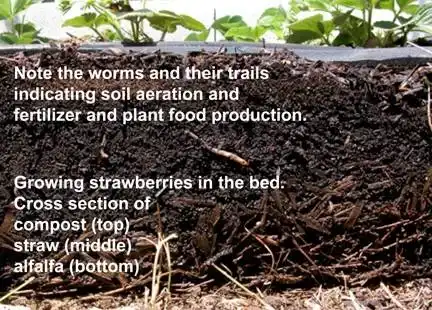
The Best Organic Growing Medium for Vegetable Gardens is what I like to call My Three Sisters. My Three Sisters is composed of Alfalfa, straw, and compost. The image is a cross-section of the Alfalfa, straw, and compost. Worms are prevalent in the mixture, adding worm casting as they consume the compost, straw, and Alfalfa, turning the mix into humus. All three layers retain water. Notice in the picture how porous the materials are.
Best Organic Growing Medium for Vegetable Gardens
I found the best organic growing medium for vegetable gardens was not dirt. Dirt has too many problems maintaining the proper nutrients, acidity, water retention and saturation, toxins in the soil, and growing conditions.
Over the years, I found a mixture of Alfalfa, straw, and compost (Dirtless Garden) combined with our unique blend of organic fertilizers that outshined dirt. The compost, Alfalfa, and straw are great at retaining water. A bale of straw can hold as much as 270 pounds of water.
The compost layer on top provides an immediate growing stratum. As the plants start sending out roots, they find little resistance to growing their root systems in the three layers. Thus, they grow faster and stronger root systems, and you know what that means – early and more plentiful harvests.
The additional benefit of heat generated through decomposing the compost, Alfalfa, and straw layers allows immediate planting after the last frost. The dirtless mixture gets warm through the breakdown process, and the plants take off. The same heat principle applies later in the season. Even on cold days, you can stick your hand into the mix and feel the warmth of the mixture. Try that with dirt!
- Extended growing season due to heat generation
- Roots penetrate the growing medium quickly.
- Exclusive use of organic nutrients
- Excellent water retention and growing conditions.
We add worm and compost teas throughout the growing season to promote and feed the plants and the fungi and bacteria that make healthy, disease-resistant plants. You will be delighted to see how fast and wholesome your plants grow.
Always the downside
Now for the downside of this gardening system. The Alfalfa and straw will break down while feeding their life-enriching nutrients to your plants. As a result, you will have to add Alfalfa, straw, and compost to your garden each year.
The repeated applications of Alfalfa, straw, and compost will build a rich humus system that will make your plants grow strong, fast, healthy, and disease-resistant. In addition, there will be little weeding since your plants will take up most of the space.
After the first season, the bottom of the raised bed will contain over a cubic yard of humus. Emptying the humus from the bed, apply a layer of cardboard on the bottom, inhibiting weed growth.
Place four bales of straw on the cardboard in the 30″ x 4′ x 8′ box. Next is to break apart a bale of Alfalfa, dispersing it evenly over the straw layer.
Soak the Alfalfa with water. The water activates the microorganisms to begin the decomposition process, which generates upon wards to over 100° heat providing the ideal growing environment.
Add about half of the humus you initially removed, covering the Alfalfa layer with approximately 5″ to 6″ of planting material. With the remainder of the humus, you can start a new 30″ x 4′ x 8′ raised bed, use the material for plant starts, or apply it throughout your garden or yard.
